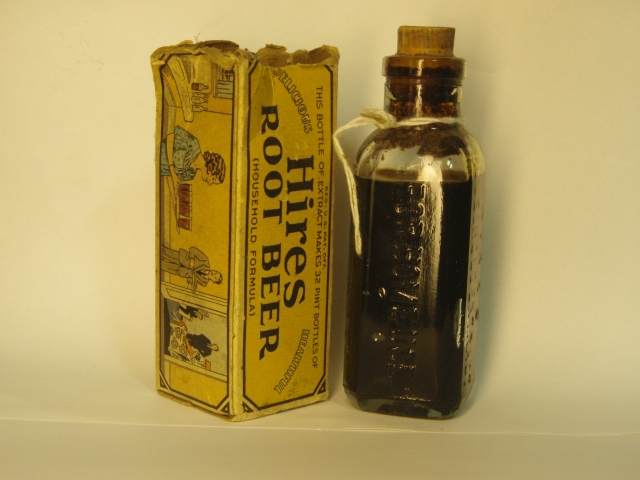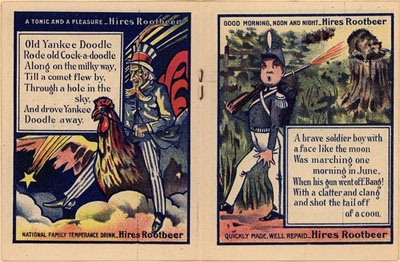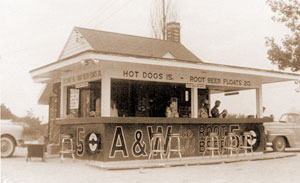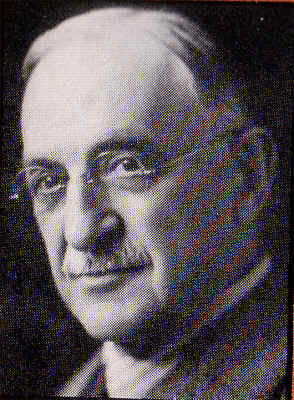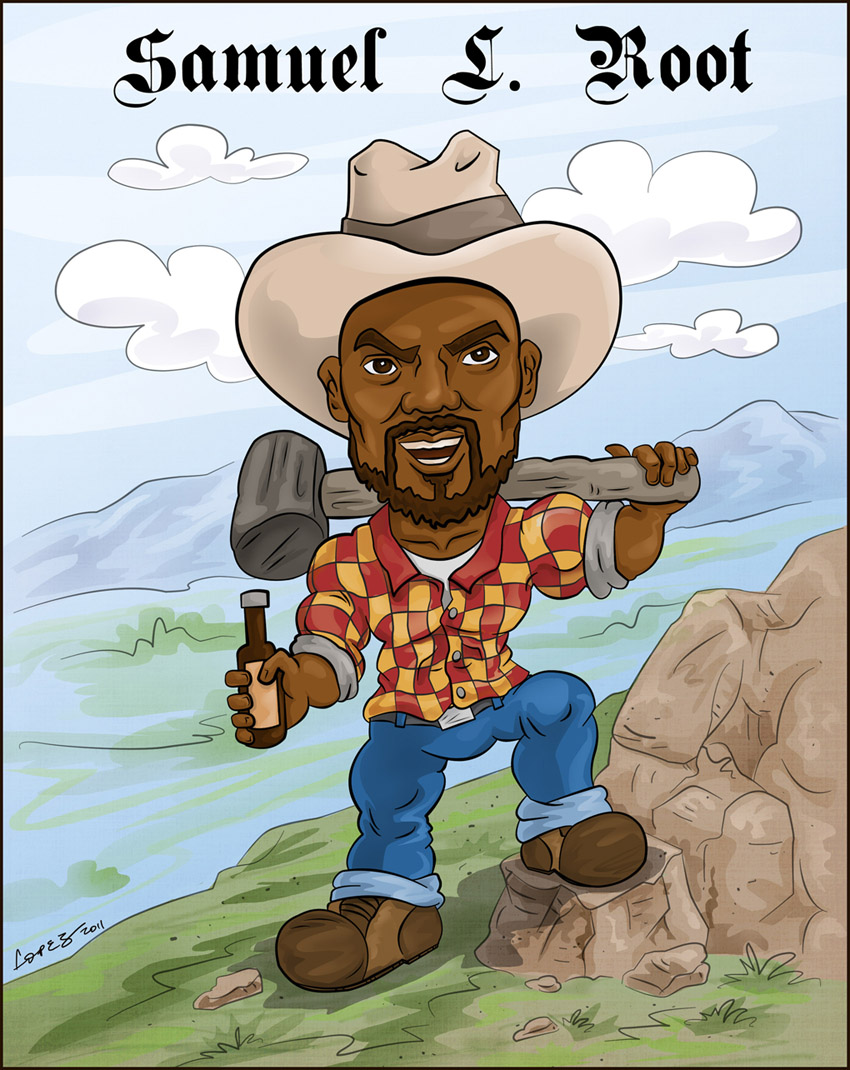
       Root Beer HistoryThe History of Root BeerE. Sortomme, Ph.D. Root beer is historically analogous to small beer, beer that was brewed to have very low alcohol content. Contrary to popular belief, Charles Hires did not invent root beer as is evidenced by the fact that there are some cook books in the Library of Congress that have recipes for root beer from 10 to 20 years before he began to sell his version [1] with the original root beer recipe potentially coming from the native Americans [2]. Indeed, mild root drinks such as sarsaparilla were brewed and enjoyed for hundreds of years before modern root beer [3]. What Hires did was to develop his own spin on the drink and popularize it though innovative business models. There is a great deal of debate regarding the actual origins of Hires’ discovery of root beer. Some historians say that he developed it while working at a confectionary store with the inspiration coming from an eccentric relative. Other historians assert that he developed the brew while working on his father’s farm. Several versions assert that he discovered the recipe while on his honeymoon. Hires’ own obituary had yet another version where he developed root beer with a local minister [4].
Regardless of how he discovered it, Hires initially started selling it at his drugstore under the label of “root tea” [1]. Eventually he changed the name to root beer. One reason given for the change is that he was active in the temperance movement and wanted to provide a non-alcoholic alternative to the hard beer drinking miners in Pennsylvania [4]. In 1876 he presented Hires’ Root Beer at the Philadelphia Centennial Exhibition, the one hundredth birthday exhibition of the USA. At the exhibition, he gave free mugs of root beer. He also showed how to transform a packet of powder into 5 gallons of root beer [2]. Four years after that Hires began selling liquid root beer concentrate around the country that could be mixed by local brewers to make root beer [1], [4]. In 1879, Hires Root Beer Co. lost the patent for the name “root beer” when congress passed a law that said that no word in the dictionary could be registered as an invention [4]. Despite this setback Hires had immense success selling his root beer. He advertised in trading cards and news papers [1], with one newspaper editor giving him free advertising because he liked root beer so much [4]. He sold 115,000 glasses of root beer his first year. After several years he had sold over 700 million glasses making him a multi-millionaire. In 1893 he began selling bottled root beer. Hires continued to lead his company until 1925 when his sons took over [4].
By this time other manufacturers had began to sell root beer extracts and bottled soda [5]-[8], and root beer became the most popular soft drink in America. One of the earliest competitors was Barq’s. The debut year for Barq’s root beer is often given as 1898, but some sources say that it was not produced until some two years later. For decades Barq's was not marketed as “root beer” in part to avoid legal conflict with the Hires Root Beer Company. Though Hires had lost the patent on the term “root beer,” the company was attempting to claim a trademark on it. Also, Barq’s was very different from other root beers at the time. Its base was a sarsaparilla drink with caffeine, less sugar, and higher carbonation than other root beer brands. Even though it had increased carbonation, Barq’s had less of a foamy “head” then the other root beers. It was decided to market the soft drink simply as Barq's. Some of the other root beers of that period, such as IBC, are still available today [6]. The most popular root beer brand also began late in this period, A&W.
A&W Root Beer began when Roy Allen set up a root beer stand at a parade in 1919 honoring veterans returning from WWI. Due to his success, he partnered with Frank Wright and they used their last name initials for the name of their new root beer [8]. The first permanent root beer stand in was opened Lodi, CA followed by a second stand in Sacramento. The stands featured the first "drive-in" concept that had "tray-boys" for curbside service. In 1924 Allen bought out his partner Wright and pursued a franchising program. This was America's first franchised restaurant chain. To ensure the quality of the root beer, he sold A&W concentrate exclusively to these franchises. By 1933, there were more than 170 A&W restaurants franchised [8]. It has been incorrectly asserted that A&W stood for Alice and Willard Marriot [9] though this confusion is the result of the fact that the Marriot’s first major business was an A&W franchise [10]. Root beer also grew in popularity with the advent of prohibition as many brewers turned to producing root beer to keep in business and beer drinkers were forced to find non-alcoholic drinks. This gave rise to even more root beer brands [11], [12]. By the 1950’s, cola had eclipsed root beer as the most popular soft drink flavor and root beer continued to lose market share. Today, root beer accounts for only 3% of the North American soft drink market and is virtually non-existent outside of North America. Nevertheless, hundreds of different root beer brands are available and they are regularly enjoyed by root beer enthusiasts.
Local Historians Argue Over the Root of HiresBy Eileen Bennett Foamy, frothy, spicy, sassy. Root beer. If an icy cold mug of the creamy, licorice- wintergreen -and-vanilla- blended soda is just your cup of tea on a warm summer day, you have Charles E. Hires of Cumberland County to thank. Hires almost named his new concoction "root tea." It was, after all, made of tea brewed from roots and herbs. But through a twist of fate, or perhaps just a clever marketing ploy, Hires was persuaded to switch the name to "root beer" to appeal to the large market of hard-drinking Pennsylvania miners. It was a decision that would prove wildly successful, making Hires a wealthy man while providing a major boost to the temperance movement, just gaining momentum in the mid-1800s.
How the drink came to be is a blend of legends similar to the beverage itself: each of the many flavors in the brew is individually distinct and interesting, but difficult to pin down. Millville historians claim Hires invented the drink in the 1870s while working at a confectionery store at High and Main streets. Hires, they say, took his inspiration from an eccentric relative, who would roam the Millville woods, "collecting bark and roots for medicinal purposes, rather than following the glass trade to which he had been apprenticed." While working at the High and Main streets store, Millville historians claim, Hires experimented with various brews, until he was satisfied with the product. He then married a wealthy widow, the tale goes, and with her backing, patented Hires Root Beer. Not so, claims Bridgeton Antiquarian League President Joseph DeLuca; DeLuca claims Hires developed his famous drink in 1876 while on his father's farm in Roadstown, Stow Creek Township. According to DeLuca, Hires grew up on his father's farm in Roadstown, just outside of Bridgeton. Even at a young age, though, DeLuca says, "he knew he didn't want to be a farmer like his father." He took a job as an apprentice to an area pharmacist at the grand salary of $12 a week, according to DeLuca. At 16, Hires moved to Philadelphia, took a job as a pharmacist's apprentice (at $10 a week), and took night classes at the Philadelphia College of Pharmacy and Science. By the time he was 18, Hires had squirreled away $400 and invested in a drugstore at Sixth and Spruce streets in Philadelphia. He invested in a potter's clay business that "really took off," says DeLuca, and before the young man knew it, he had $5,000 in the bank. That allowed him to divulge in his real passion ã the spicy, foamy drink not yet called root beer. The new brew was described as "woodsy-," "minty-," and even "medicinal-" tasting. Crush International, Inc. of Cincinnati, Ohio, which now produces Hires Root Beer, offers up a slightly more romantic version of the tale. The company says Charles Hires, a Philadelphia pharmacist who originally hailed from Roadstown, spent his honeymoon on a New Jersey farm. "It was there that he discovered an exciting new drink made of 16 wild roots and berries, including juniper, pipsissewa, spikenard, wintergreen, and sarsaparilla and hops," states the company. And yet another version conjures up a slightly more devious slant to the story: while on his honeymoon at a southern New Jersey farm, the legend goes, Hires persuaded his hostess to part with her recipe for the root tea she served. Her recipe called for 26 roots, berries and herbs ã similar to a recipe used by Native Americans for years. Hires then packaged the mixture in boxes and sold it to be mixed with water, sugar and yeast to housewives and soda fountains. But DeLuca has been studying the hometown-boy-makes-it-big story for years. He's heard the honeymoon story, and, romantic as it might sound, he hasn't been able to verify it. "Legend has it he was vacationing on a farm," says DeLuca, "but I think he was just visiting his parents' farm in Roadstown. DeLuca's been scouring the archives for years in search of the real Hires story. He's been able to ferret out some of the basic facts of Hires' life from newspaper articles and tidbits of trivia, although he admits, "There's not much there." Charles E. Hires' obituary, which ran in the Bridgeton Evening News on Aug. 2, 1937, gives yet a different version of events. The obituary says that the Rev. Dr. Russell Conwell, the founder of Temple University, asked Hires to help him concoct a beverage that might be sold among hard-drinking Pennsylvania miners in the interest of the temperance movement. Hires, who was studying medicine at Jefferson Medical College in Philadelphia at the time, was happy to comply, and was assisted by two medical professors. Conwell, smitten with the results, convinced Hires to call it a "beer," instead of a "tea," feeling it would be an easier sell to the working class. This seems to be the one point in the Hires story on which all parties seem to agree: marketing it as a "beer" instead of a "tea" was the key to its success. Hires would become the largest manufacturer of the soft drink "root beer" in the world. But at first the drink was slow to catch on. Hires sold his drug business and went into the wholesale business, specializing in vanilla beans. He made a trip to Mexico, studied the vanilla plant and wrote a small book on the subject - long considered to be the authoritative work on vanilla. Conwell persuaded Hires to present his product at the 1876 Philadelphia Centennial Exhibition. Four years later, Hires marketed a liquid concentrate and in 1893 launched a bottled, ready-to-drink product. According to DeLuca, the demand for the drink (the recipe supposedly consisted of sugar or honey with such ingredients as sarsaparilla, sassafras, licorice extracts, and vanilla and wintergreen) skyrocketed. A sideline plus: it contained no caffeine. "He took the ingredients and began to experiment with the mixture," says DeLuca. As it turned out, the editor of the Public Ledger, a gentleman by the name of George W. Childs, liked the drink so much, he gave Hires free advertisement in his newspaper. One of the most successful ventures in the history of marketing began to take shape. "He sold 115,000 glasses of his product during the first year it was marketed," says DeLuca. "That quickly expanded to 700 million glasses. He became a multimillionaire." The Hires Root Beer Co. lost the patent for the name "root beer" in 1879. That's when Congress passed a law stating that no word in the dictionary could be registered ã a law that was repealed in 1920. Hires stayed at the helm of his business, Hires, Wright & Brooks drugstore in Philadelphia until 1925 when his sons took over. Hires, who was active in the temperance and Quaker movements, died at the age of 85 in Haverford, Pa., on Aug. 1 1937, leaving behind more questions than answers regarding his drink. Geneaological records provided by descendant William L. Hires to the Millville Historical Society show the root-beer king was actually born in Elsinboro on Aug. 19, 1851. Hires' obituary, in fact, lists his place of birth as Roadstown. Taken from The Press of Atlantic City; Cumberland County 250th Anniversary Special - 6/28/98
That is what they think, this is what I think happened: The Root of Root Beer - The Legend of Samuel L. RootRoot beer was invented back in 1874. Back when all the beer had alcohol in it. But there was sarsaparilla, a small beer with very limited alcohol, which tasted like root beer. Most people were ok with this status quo except for the Mormons and the Temperance movement. They both felt that there should be zero alcohol in the drinks. Into this setting stepped Samuel L. Root. Sam was as rugged a man as the late nineteen century could offer. As a child he tended several tree nurseries of Johnny Appleseed. He also traveled about with Johnny collecting seeds and planting with him. While that was fun and all, it was too easy, so after a few years Sam left for more hardy labor. He found it at the C&O Railroad, where he worked his teenage years away as a steel driver. He would race John Henry drilling holes. Though he never won, he was the only man on in the whole company who could give John any competition. After the fateful race, against the steam drill, Sam realized that he was the only man left that could outdrive a machine, and figured he better find a career could last a little longer. He liked pounding his hammer so moved on to driving railroad spikes, and was the fastest driver around. He was hired by the Union Pacific to work on the transcontinental railroad. Samuel was so fast that it took three other men to keep up with him on the opposing rail. It was largely due to him that the Union Pacific arrived first at Promontory Point. After that major victory, he was bored of the railroad work and continued on west to become a lumberjack. Shortly thereafter, he met Paul Bunyan. Paul took a likin’ to Sam and they worked together for several years. Sam was the only man other than Paul who could hold Babe steady when the ox wanted to wander. Sam could cut half as much wood as Paul in a day, which is saying a lot. Though he liked cutting trees, he got tired of all of the rain in the Pacific Northwest, and decided to go to somewhere much dryer. He went down to Arizona and took up the toughest job he could find, breaking bronc’s. Samuel was near the best there was, he could ride any bronc’ no matter how rough and mean. One day he found a bronco so rough that over a hundred men had tried to ride and every one of them failed. Sam was about to give it a try when Pecos Bill loudly declared that he would ride it. Well Sam never was one to start an argument and so he let old Pecos Bill put that bronc’ in place. Sam and Bill became friends after that and traveled around Texas, New Mexico, and Arizona riding bulls and bronc’s that men said couldn’t be ridden. Sam never did try and ride a tornado though, he left that to Bill. On their way through Utah, Sam met the prettiest sweetest girl that ever there was. Now this little lady was a Mormon and Sam decided to get to the bottom of that religion. We’ll skip those details but soon Sam parted company from Bill and joined the LDS church. He married his sweetheart and settled in Utah. As he was a lookin’ for a tough job there, he met Porter Rockwell, who was so impressed with Samuel, that he deputized him. Sam rode with Porter and his posse, enforcing the law, for the next several years. Then Sam and his wife, Lily, decided to move back East for awhile and they settled in Pennsylvania, where Samuel took up coal mining in 1874. Well miners are known for their hard drinking nature, and Sam had been no different before he became a Mormon, but now he couldn’t find a proper drink to quench his mining induced thirst. Sam wanted to drink a beer, but wanted no alcohol whatsoever in it, not even the faint traces that were in Sarsaparilla, which he also loved. Well Samuel L. Root was never one to back down from a challenge so he assembled the best ingredients he could find to make a beer for Mormons that tasted something like Sarsaparilla. He used vanilla beans, sassafras root, pure cane sugar, raw honey, some cinnamon and nutmeg, and some other spices and he brewed up the most delicious drink that anyone had ever tasted. He called to Lily, “Pass me a bottle, the one that says, ‘Bad Mother’ on it!” and he named the beer after himself, Root Beer. And thus was root beer was born. With so many versions of how root beer was created, it would take a Cincinnati criminal lawyer to sort them all out to find the truth. Any lawyer or legal professional knows that protecting patents and trademarks have changed quite a bit since the early days of root beer, mainly due to today's Internet and worldwide media. |
follow me on:
|

